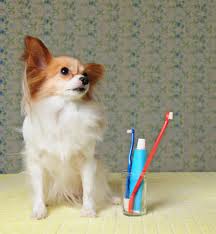Many dog owners take care of their dogs by feeding them healthy food, taking them for regular vet visits and exercising them. However, far fewer brush their dogs’ teeth regularly or even give their dental care much thought. Just like humans, dental care in dogs is very important. In fact, many dogs show signs of gum disease by four years of age because of poor dental care. Here are some ways to take care of your dog’s teeth and learn what signs to look for that require medical attention.
Inspecting your dog’s mouth
You should inspect your dog’s mouth about once a week and start with the breath. Although it will not likely smell like flowers, it should not be too terribly offensive. If your dog’s breath makes you want to gag, and if your dog has been drinking and urinating excessively and vomiting, then a vet visit may be in order.
You should inspect your dog’s teeth by lifting up his lips all the way around his mouth. It is important that you do this gently and with caution so your dog does not bite you. Check the teeth and ensure that no brown spots are present. This indicates tartar buildup. The gums should be pink with no signs of inflammation or bleeding. If they are red or white, this indicates gum disease.
Symptoms of poor dental conditions
The most common problems are tartar/plague buildup and gingivitis. If you notice any of these warning signs, it is likely time to see the vet:
- Loose teeth
- Bad breath
- Inflammation in the gums
- Heavy drooling
- Difficulty chewing (this will affect eating habits)
- Tumors or cysts in the gums or tongue
Common disease and how good dental care can help
- Gingivitis is caused by the buildup of tartar, plague and disease producing bacteria and leads to swollen gums.
- Halitosis, a fancy word for bad breath, is caused by bacteria feeding on food caught in the mouth.
- Periodental disease occurs when there is an infection between the teeth and gums. This can be painful and result in tooth loss.
Regular brushing reduces the chance of tartar, plague and food buildup. This deprives harmful bacteria, etc., a food source and a place to grow.
Choosing toothpaste
You can make toothpaste out of baking soda and water or ask your vet for toothpaste that is specially formulated for dogs. You should never use human toothpaste on a dog, as it can cause stomach irritation. When buying toothpase, here are some things to consider:
- Size – It might be good to start off with a smaller size in case your dog doesn’t like it.
- Flavor – Most toothpastes are made from a type of meat, such as beef or chicken, to make tooth brushing more enjoyable for your dog.
- Ingredients – You want to avoid toothpastes made from too much sugar, alcohol or ingredients that your dog may be allergic to.
- Digestibility – The toothpaste should be edible. It should not cause an upset stomach, vomiting, diarrhea or any other health conditions when consumed.
- Form – Some dogs prefer liquids over pastes or gels. You may need to experiment with the various forms before you find one that your dog enjoys.
You may also want to consider the cost and availability of the toothpaste.
Brushing your dog’s teeth
Ideally, you should brush your dog’s teeth every day, but four times a week is probably a more realistic goal. You can buy a special toothbrush for your dog at your local pet store or use a piece of gauze and rub it around your dog’s teeth. The best toothbrushes are double-headed and have a 45-degree angle to better clean the gums. A larger dog may need a brush with a longer handle.
Keep in mind that puppies should have all their adult teeth by seven months, you can buy brushes for puppies, and it is best to start early.
Tips for brushing
Introduce your dog to brushing gradually and never force the brush into the mouth. It’s best to start after a lot of exercise when the dog has less energy. At first, simply get your dog used to having your fingers in his mouth. Just rub the teeth and gums, preferably when they have the flavor of a favorite food on them. Then, slowly introduce the toothbrush, without toothpaste at first.
Over time, increase the area covered until you are brushing the entire mouth. Brushing should be done with the brush at a 45-degree angle, focusing on one area at a time to clean the gumline. Bushing should be done in small circles. Remember that the back outside of the teeth needs the most attention. A picture guide can be found here.
Keep the experience fun, while making sure that your dog gets lots of praise for being a good sport. Try different flavors of toothpaste to see what he likes.
An oral rinse is another option. Chlorhexidine oral rinse and gel, although dogs often do not like the taste, is effective and can be squirted into the mouth. You should try to have your dog’s teeth cleaned professionally several times a year if possible.
Food and chews
Dry food is better for the teeth than soft food, as soft food is more likely to stick to the teeth. Synthetic chew bones and toys strengthen and clean dogs’ teeth and gums as they chew (as do raw meaty bones). These also satisfy the instinctive desire dogs have to gnaw on things and reduce stress.
The following are videos on how to brush your dog’s teeth.
If your dog has bad breath, you can buy products to keep your dog’s breath smelling fresh. Your local pet store should have products such as sprays, chews and bones. Amazon has a good selection of these.
